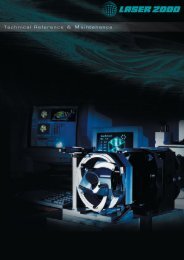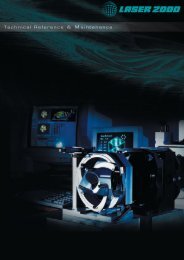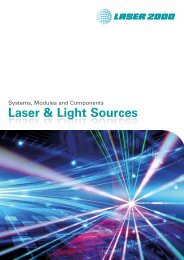Semrock Master Catalog 2018
Semrock Master Catalog 2018
Semrock Master Catalog 2018
Create successful ePaper yourself
Turn your PDF publications into a flip-book with our unique Google optimized e-Paper software.
VersaChrome ® Tunable Filters<br />
TECHNICAL NOTE<br />
Spectral Imaging with VersaChrome ® Filters<br />
Conventional spectral imaging systems are generally not able to offer the key advantages of thin-film interference filters,<br />
i.e., high transmission combined with steep spectral edges and high out-of-band blocking. Now with VersaChrome filters,<br />
these advantages can be realized in simple spectral imaging systems for applications ranging from fluorescence microscopy<br />
to hyperspectral imaging.<br />
To demonstrate spectral imaging in a fluorescence microscope, a “lambda stack” of images (corresponding to a nearly<br />
continuous series of emission wavelengths) was acquired of a sample labeled with three spectrally overlapping fluorophores<br />
using a <strong>Semrock</strong> VersaChrome tunable filter (TBP01-617/14) placed in the emission channel of a standard upright<br />
microscope. Figure 1 shows six of the 61 images taken at 1 nm intervals, and Figure 2 shows measured intensity spectra<br />
taken from parts of the image where only a single fluorophore is present. The nucleus labeled with SYTOX ®<br />
Orange can<br />
be easily discriminated from the other cellular structures (Fig. 1). However, since the F-actin and mitochondria are labeled<br />
with fluorophores that are highly overlapping (Alexa Fluor 568 and MitoTracker ®<br />
Red, respectively), linear unmixing is<br />
necessary to discern the corresponding cellular constituents. Images deconvolved with linear unmixing are shown in Figure 3.<br />
It is important to note that the spectral properties of these tunable filters are almost identical for both s- and p-polarizations<br />
of light – a feature that cannot be easily obtained using liquid-crystal and acousto-optic tunable filters. Polarization<br />
independence is highly desirable for spectral imaging systems, and yet polarization limitations of current tunable filters<br />
account for a loss of at least half of the signal in most instruments. Therefore VersaChrome filters not only enhance the<br />
throughput in spectral imaging but they also greatly simplify the complexity of instrumentation.<br />
1.0<br />
0.9<br />
0.8<br />
0.7<br />
0.6<br />
620 nm 610 nm 600 nm<br />
0.5<br />
Nucleus: SYTOX Orange F-Actin: Alexa Fluor 568<br />
0.4<br />
SYTOX Orange<br />
0.3<br />
Alexa Fluor 568<br />
MitoTracker-Red<br />
0.2<br />
Background<br />
0.1<br />
0.0<br />
590 nm 580 nm 570 nm<br />
570 580 590 600 610 620<br />
Wavelength (nm)<br />
Mitochondria: MitoTracker Red Composite image<br />
Figure 1 Figure 2 Figure 3<br />
Normalized Intensity<br />
Fluorophores<br />
Single-band<br />
Sets<br />
Multiband<br />
Sets<br />
Cubes<br />
Laser<br />
Sets<br />
MyLight TM<br />
Interested in seeing how a <strong>Semrock</strong> standard<br />
filter behaves at a particular angle of<br />
incidence, state of polarization<br />
or cone half angle of illumination?<br />
Simply click the<br />
Click for MyLight Tool<br />
button located above the spectral graph<br />
and the MyLight window will access our<br />
theoretical design data and allow you to see<br />
spectral shifts in filter performance under<br />
varying illumination conditions. You can also<br />
expand (or contract) the displayed spectral<br />
range and assess filter performance in real<br />
time that previously required you to contact<br />
us and iterate towards an answer. MyLight<br />
data can be downloaded as an ASCII file and<br />
the graphs printed or saved as PDFs.<br />
NLO<br />
Filters<br />
Dichroic<br />
Beamsplitters<br />
Tunable<br />
Filters<br />
Individual<br />
Filters<br />
79<br />
More
















